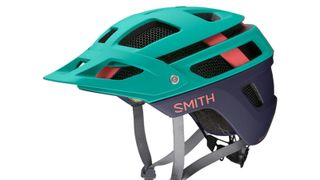The best half-shell mountain bike helmets are designed to offer increased protection around the back and side of your head without impeding airflow like a full-face helmet does.
Crashes when riding off-road can be extremely unpredictable. Whether it’s skidding out on a slippery tree root or going straight over the handlebars, when things go awry, having the extra protection of a half-shell mountain bike helmet can be crucial and will earn its value by protecting you from severe injury during a crash.
The MTB helmet market is enormous, with a rich diversity of options: design, fit, comfort, safety features and fashion are all elements which might influence your decision, so a considered approach is required to get the best mountain bike helmet for your requirements.
It is also important to not continue to use MTB helmets after a crash. Your helmet is designed to absorb and deflect the trauma of a single big crash. Even if it appears structurally undamaged, a visual inspection isn’t enough: the internal structural integrity could be too compromised to take another impact. A golden rule is to never use a helmet that you have crashed heavily with. Despite having an undamaged appearance, it has done its job, and you now need another.
To help you choose the best half-shell mountain bike helmet for your needs, we've rounded up our favorites that you can buy today, outlining what makes them good, and who they're best suited for. If you feel like you need some more information to help you make that decision, head on down to our guide about how to choose the best half-shell mountain bike helmet.
- Best XC helmets: cross-country and marathon helmets to give the racing advantage
- Best full-face mountain bike helmets: ultimate head protection for serious gravity riding
Best half-shell mountain bike helmets
Why trust BikePerfect

Giro makes some of the best half-shell mountain bike helmets from entry level to enduro racing, so it's no surprise that its trail offering tops our list. The Giro Manifest not only sports excellent levels of ventilation but steps up safety by integrating Giro's Spherical MIPS technology into a trail helmet. The Spherical MIPS, which has previously been used in Giro's Aether road helmet and Tyrant enduro lid, uses elastomer tethered inner and outer helmets sliding over each other to reduce the Gs. The lower helmet is also made of a different density designed to absorb low-speed loads while the upper segment is designed to dissipate high-speed loading better.
Giro has also nailed the fit as well, with a shape that works for a wide range of head shapes, backed up with Giro's proven Roc Loc Trail Air fit retention system. Detailing is second to none as well, the peak is bolted and angle adjustable and there are rubber gripper patches on the back of the helmet for goggle straps and inside the crown for glasses. There are subtle reflective details on the rear and it comes in seven colors, with the slip plane ‘sandwich filling' picked out in a contrasting color so people know you’ve invested big in protecting your brain.

Sweden has contributed handsomely to the current offering of mountain bike helmet technologies and POC has once again elevated its offering with the Tectal Race Spin.
With a snowsport safety background and headed by a team of surgeons, POC’s entire design approach is safety-centric. This new helmet incorporates helmet tech that could save your life. This comes in the form of a digital chip that stores crucial medical information and can be accessed using NFC technology. That means that if you do crash, and can’t speak, a response team can render critical first aid using information extracted from your POC helmet’s digital data chip.
To negate rotation impact injuries this latest Tectal Race helmet features POC’s SPIN (Shearing Pad INside) technology. Around the back there is a very clever goggle clip, which will appeal to enduro riders.

The Forefront 2's unique design feature is the Aerocore construction, which has 30 per cent better energy absorption than EPS foam. You’ll find a MIPS liner inside too, for rotation deflection mitigation. Smith Optics also uses a structure sourced from Koroyd, a specialist safety technology company based in Monaco. This features a grid of collapsible polymer cylinders, which provides outstanding airflow management and energy absorption.
Beyond the great safety features, Smith’s Trace features 20 ventilation ducts, which means it is a delightfully cool helmet to wear on a sweltering all-day weekend ride.

Few rivals can offer the value of the Singletrack II. Molded with generous coverages, this is a trail helmet that feels both snug and safe.
It also has 14 ventilation ports, which means that the Singletrack II is a great choice for warm weather rides. The material removed for shaping those ample ventilation ports means the Singletrack II is light too.
An adjustable visor makes stowing your goggles a cinch. The only real issue is a lack of rotational impact protection, as the Singletrack II does not feature an energy-absorbing liner, such as MIPS.

Despite being a budget helmet, the Leatt DBX 1.0 MTN comes with a healthy chunk of tech which makes it one of the best entry-level enduro-capable helmets on the market.
The DBX 1.0 is packed with nine 360 Turbine Technology wheels which provide a damped movement between the helmet and head during impacts. Leatt claims a 30 per cent reduction in head impact loads at concussion levels and a 40 per cent reduction in rotational G transfer.
There are 14 decent-sized vents that lead to internal channeling to keep the head cool although it's not as effective at slower speeds when compared to pricier options. The one-piece padding is decently comfortable and there is an adjustable visor to help keep sun or rain out of the eyes.
How to choose the best half-shell mountain bike helmet
Any helmet is a compromise between weight, safety and comfort. The helmet’s primary function is protection, but for most of its lifecycle, it will be an accessory judged on comfort.
With the helmet secured, riders want to have the confidence that if something does go wrong, their helmet will validate its protection rating.
1. Comfort
Comfort is crucial. When you are riding in warm conditions having ample cooling airflow is important. To build a helmet structure that allows sufficient airflow, without compromising structural safety, is deeply challenging.
2. Structure
Engineering a crash safety-compliant structure, with enough ports that will cool your head, even at low riding speeds, is a special industrial design skill. Moisture management is another consideration: when you start perspiring, you want a helmet that will prevent moisture from running into and stinging your eyes.
3. Fit
Although the helmet’s fastening system does allow for adjustability, certain mountain bike helmet brands will be superior in their molded fit for specific riders. The only way to know is by trying on a few different brands and feeling which is most comfortable for your cranial profile.
4. Rotational protection
Although the helmet’s primary function is to absorb energy during a crash, preventing head trauma, its safety features are not merely structural. During the last few years, helmets have been marketed with a variety of rotational acceleration mitigating technologies. Amongst these, the MIPS liner is most famous, but there are now an array of liners that prevent rotational acceleration of the head if you crash at a peculiar angle.
5. Visor
Depending on your dominant riding climate and geography, you might want a visor. Although a visor is less aerodynamic, it does have the benefit of shading you during a warm day in open terrain. It is also handy when descending a technical trail into a setting sun, with the visor capable of blocking some of the direct sunlight which could blind you at a critical moment, when rolling into a technical trail feature.
Fixed visors aren’t sensible for those riders who wish to prioritize efficiency above all else. For mountain bikers who live in particularly windy areas and ride on open dual tracks at higher average cadence speeds, a visor can be annoying, with the wind snatching at it. Adjustable and removable visors are preferable.
6. Safety
We’ve established which comfort features you should evaluate, depending on your local riding area’s climate, but what about the helmet’s reason for being: safety? The helmets on our list have all passed fundamental validation, but there are newer technologies that can assist you in the unfortunate scenario of a crash.
A brilliant new technology, which has incubated from Sweden, along with many other helmet safety technologies, are data chips. Using NFC technology, helmets can now dispense medical information about a rider, after they have crashes, without requiring an active data signal.
Peripheral issues which might influence your helmet choice are camera mounts and goggle clips, but these should not be atop your list of requirements.


